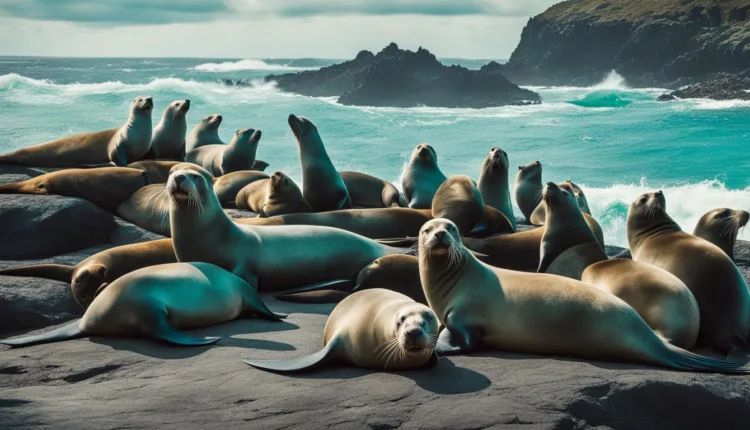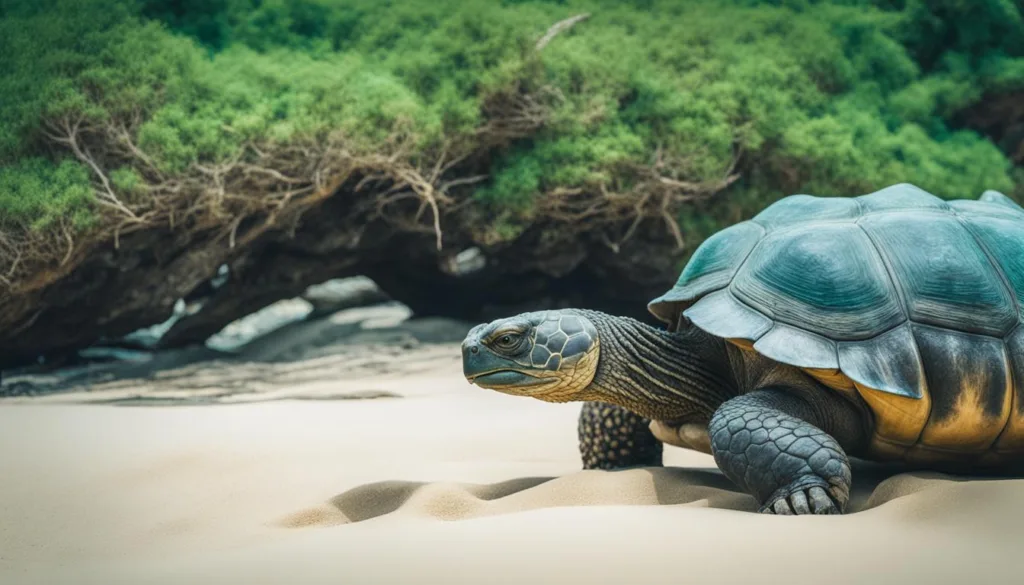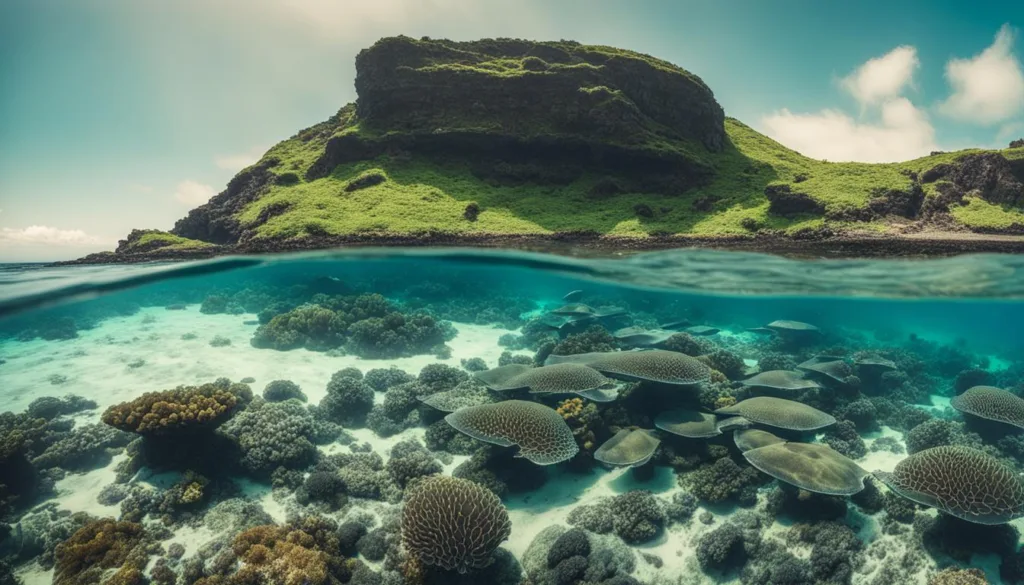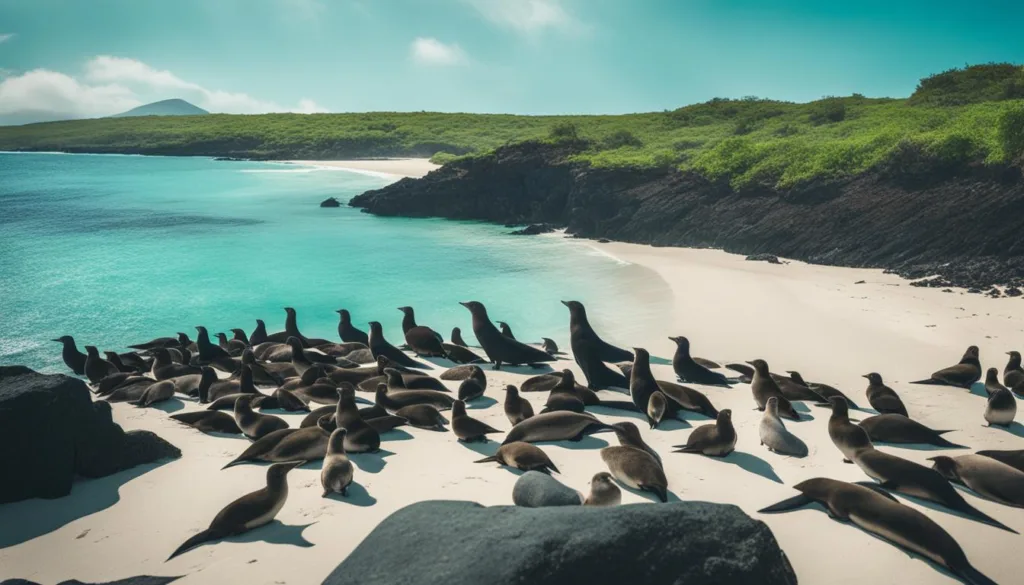Galápagos Islands (Ecuador): A Paradise of Unique Wildlife and Pristine Beaches

Welcome to the Galápagos Islands, an extraordinary destination located about 1,000 km from the Ecuadorian coast. As a travel advisor, I’m thrilled to guide you through the wonders of this breathtaking archipelago. With its unparalleled wildlife and untouched beaches, the Galápagos Islands offer an experience like no other. Immerse yourself in a living museum of evolution, with unique species and geological formations shaped by volcanic activity.
Recognized as a UNESCO World Heritage Site and Biosphere Reserve, the Galápagos Islands are highly protected as a national park and marine reserve. Prepare to be amazed by the incredible diversity of wildlife, including giant tortoises, blue-footed boobies, and vibrant marine life.
Key Takeaways:
- Explore the Galápagos Islands for a one-of-a-kind experience of nature’s wonders.
- Witness unique wildlife, including giant tortoises and blue-footed boobies.
- Appreciate the geological features shaped by volcanic activity.
- Discover the beauty of the Galápagos Marine Reserve and its diverse marine life.
- Support conservation efforts and engage in responsible tourism practices for a sustainable future.
A Brief History of the Galápagos Islands

The Galápagos Islands have a fascinating history that spans several centuries. They were first discovered by the Spanish in 1535, who named them after the giant tortoises that inhabit the islands. Over the years, the islands attracted pirates, buccaneers, and whalers who used them as a hideout and a source of fresh protein. However, it was the visit of Charles Darwin in 1835 that truly put the Galápagos Islands on the map.
During his voyage on the Beagle, Darwin collected valuable specimens from the islands that later inspired his theory of evolution. He observed the unique wildlife and geological formations influenced by ongoing volcanic activity. Darwin’s visit and subsequent publications brought global recognition to the Galápagos Islands for their ecological importance.
“The natural history of this archipelago is very remarkable: it seems to be a little world within itself.”
In recognition of their outstanding universal value, the Galápagos Islands were declared a UNESCO World Heritage Site in 1978. This prestigious designation highlights the islands’ significance as a living laboratory of evolution and their importance in understanding the processes that have shaped life on Earth.
| Year | Event |
|---|---|
| 1535 | Spanish discover the Galápagos Islands |
| 1835 | Charles Darwin visits the islands on the Beagle |
| 1978 | Galápagos Islands declared a UNESCO World Heritage Site |
The history of the Galápagos Islands is intertwined with the exploration of the natural world and the development of the theory of evolution. Today, visitors have the opportunity to walk in the footsteps of Darwin and witness the unique wildlife and geological wonders that continue to inspire and captivate.
The Unique Wildlife of the Galápagos Islands

The Galápagos Islands are renowned for their exceptional wildlife, with many species found nowhere else on Earth. These isolated islands, located in the Pacific Ocean, have become a haven for various endemic species and a hotspot for conservation efforts. From the iconic Galápagos tortoise to the fascinating marine life, the archipelago offers a once-in-a-lifetime opportunity to witness nature’s marvels up close.
One of the most famous inhabitants of the Galápagos Islands is the Galápagos tortoise. These gentle giants can reach impressive sizes, with some individuals weighing over 500 pounds. With their slow pace and unique personalities, encountering a Galápagos tortoise in its natural habitat is a truly unforgettable experience.
The Galápagos Islands are also home to a diverse array of bird species, including the magnificent blue-footed booby and the flightless cormorant. These unique birds have adapted to their island environment in remarkable ways, showcasing nature’s ability to evolve and thrive under challenging conditions.
| Species | Endemic to the Galápagos Islands |
|---|---|
| Galápagos Tortoise | Yes |
| Blue-footed Booby | Yes |
| Flightless Cormorant | Yes |
Galápagos Marine Life
Not to be overshadowed by its land-dwelling inhabitants, the Galápagos Islands also boast an incredible diversity of marine life. Snorkeling and diving in the crystal-clear waters surrounding the islands offer an opportunity to encounter sea lions, penguins, marine iguanas, and an abundance of colorful fish species. The underwater world of the Galápagos is a true paradise for marine enthusiasts and photographers.
The conservation of this unique wildlife is of utmost importance. The Galápagos National Park and various conservation organizations work tirelessly to protect and preserve the fragile ecosystems of the islands. Strict guidelines are in place to ensure minimal impact on the wildlife and their habitats, allowing future generations to continue appreciating the natural wonders of the Galápagos Islands.
Volcanic Origins and Geological Features of the Galápagos Islands
The Galápagos Islands owe their stunning landscapes and unique geological features to their volcanic origins. Positioned at the confluence of the Pacific, Cocos, and Nazca tectonic plates, the islands experience ongoing seismic and volcanic activity. With 13 active volcanoes and more than 50 eruptions recorded in the last 200 years, the Galápagos Islands rank among the most active volcanic areas in the world.
These volcanic origins have shaped the diverse and captivating landscapes of the archipelago. From rugged cliffs and volcanic peaks to lava fields and pristine beaches, the Galápagos Islands offer a visual feast for adventurers and nature enthusiasts alike. The contrasting formations and colors create a dramatic backdrop for the remarkable wildlife that thrives in this unique environment.
To fully appreciate the volcanic origins of the Galápagos Islands, visitors can explore the lava tunnels that are a product of past volcanic activity. Formed by flowing lava, these underground passages provide a fascinating glimpse into the geological forces that shaped the islands. The tunnels vary in size and length, some extending for hundreds of meters, and offer an otherworldly experience as visitors navigate through their dark and winding paths.
Table: Volcanic Activity in the Galápagos Islands
| Volcano Name | Last Eruption | Height (meters) |
|---|---|---|
| Wolf | 2015 | 1,707 |
| Cerro Azul | 2021 | 1,689 |
| Sierra Negra | 2018 | 1,124 |
| Alcedo | 1993 | 1,050 |
| La Cumbre (Fernandina) | 2021 | 1,476 |
The Galápagos Islands are not only a testament to the power of volcanic activity but also provide a unique opportunity to witness the ongoing processes that shape our planet. Visitors can explore these geological wonders and marvel at the incredible forces of nature that continue to shape the Galápagos Islands today.
Galápagos Marine Reserve: Protecting the Biodiversity of the Islands

The Galápagos Marine Reserve is a vital component of the conservation efforts in the Galápagos Islands, playing a crucial role in protecting the marine biodiversity of this unique ecosystem. Covering an area of 198,000 square kilometers, the reserve is one of the largest and most biologically diverse marine protected areas in the world. It is home to a wide range of marine species, including coral reefs, sharks, rays, and vibrant tropical fish.
Being a UNESCO World Heritage Site and a UNESCO Biosphere Reserve, the Galápagos Marine Reserve is subject to strict conservation measures to ensure the long-term survival of the marine life in the archipelago. Fishing restrictions and the implementation of a network of marine protected areas are among the measures in place to safeguard the delicate balance of the marine ecosystem.
The rich marine biodiversity of the Galápagos Islands not only attracts tourists but also serves as a significant source of scientific research and study. The reserve provides scientists and researchers with a unique opportunity to explore and understand the complex relationships between different marine species and the ecological dynamics of the archipelago.
By preserving the Galápagos Marine Reserve, we ensure that future generations can continue to appreciate the beauty and importance of this underwater paradise. It is our responsibility to support the conservation efforts and promote sustainable and responsible tourism practices that minimize our impact on the marine environment.
Galápagos Islands Conservation Efforts
The Galápagos Islands are recognized as a model for conservation and sustainable tourism. Efforts have been made to preserve the unique ecosystems of the islands and protect the endemic species that call it home. The Galápagos National Park and the Galápagos Marine Reserve have implemented strict regulations to control tourism activities and limit the impact on the environment.
Visitors to the islands must be accompanied by licensed guides and adhere to specific guidelines to ensure minimal disturbance to the wildlife and fragile ecosystems. Additionally, conservation organizations and research institutions work on various projects to monitor and protect the biodiversity of the Galápagos Islands.
Through these conservation efforts, the Galápagos Islands aim to maintain the delicate balance between tourism and environmental protection. Sustainable practices, such as waste reduction, energy conservation, and responsible wildlife viewing, are encouraged to minimize the impact on the islands’ fragile ecosystems.
Conservation Initiatives
The Galápagos Islands have implemented several conservation initiatives to protect the unique biodiversity of the archipelago. Some of these initiatives include:
- Strict limitations on the number of visitors allowed on the islands at any given time, as well as specific visitor site access restrictions to prevent overcrowding and habitat disturbance.
- Controlled introduction of invasive species and aggressive eradication programs to protect endemic fauna and flora.
- Reforestation projects to restore the native vegetation and prevent soil erosion.
- Monitoring programs to track the populations and behaviors of endemic species, such as the Galápagos tortoise.
These conservation initiatives are essential for maintaining the unique biodiversity of the Galápagos Islands and ensuring their long-term survival for future generations to enjoy.
“The conservation efforts in the Galápagos Islands are crucial for preserving the natural beauty and unique wildlife that make this archipelago so special. It is our responsibility as visitors to respect and protect this fragile ecosystem, so that future generations can continue to experience its wonders.” – Olivia Grace, Travel Advisor
Exploring the Galápagos Islands: Land and Sea Adventures

When it comes to exploring the Galápagos Islands, there is no shortage of exciting land and sea adventures to embark on. Whether you prefer guided tours, cruises, hiking, or snorkeling, the Galápagos Islands offer a wide range of activities that allow you to immerse yourself in the natural wonders of the archipelago.
Guided tours are a popular choice for visitors who want to gain insights into the unique geological features, flora, and fauna of the islands. Accompanied by knowledgeable guides, you can explore lava fields, volcanic peaks, and stunning landscapes while learning about the fascinating history and conservation efforts of the Galápagos.
If you prefer a more immersive experience, a cruise is an excellent way to visit multiple islands and discover the diverse marine life of the Galápagos. From swimming with sea lions to spotting penguins and marine iguanas, every day on a Galápagos cruise offers a new adventure and the opportunity to witness the incredible wildlife up close.
Hiking enthusiasts will be delighted by the numerous trails available on the islands. Whether it’s a challenging trek up a volcano or a leisurely walk through a mangrove forest, hiking in the Galápagos allows you to appreciate the natural beauty and breathtaking landscapes while encountering unique species along the way.
Hiking Trails in the Galápagos Islands
| Island | Trail Name | Difficulty Level | Highlights |
|---|---|---|---|
| Isabela | Sierra Negra Volcano | Challenging | One of the most active volcanoes in the Galápagos, breathtaking panoramic views |
| Santa Cruz | Tortuga Bay | Easy | Pristine white sand beach, marine iguanas, and nesting sea turtles |
| Florena | Punta Cormorant | Moderate | Flamingos, green sea turtles, and a unique green sand beach |
For those who want to delve into the underwater world, snorkeling is a must-do activity in the Galápagos. Dive into crystal-clear waters teeming with colorful fish, sea turtles, and playful sea lions, and witness the incredible marine biodiversity that the islands are famous for.
Whether you choose to explore the Galápagos Islands by land or sea, the adventures that await you are sure to leave you with lasting memories. From hiking to snorkeling, each activity offers a unique perspective of the archipelago’s natural beauty and allows you to connect with the extraordinary wildlife that calls the Galápagos home.
Galápagos Islands Attractions and Points of Interest

The Galápagos Islands are filled with attractions and points of interest that showcase the unique features and wildlife of the archipelago. From lava tunnels to pristine beaches, there is something for every visitor to enjoy.
Lava Tunnels
One of the most fascinating attractions in the Galápagos Islands is the lava tunnels. These natural formations were created by volcanic activity and provide a unique underground experience for visitors. Explore the intricate network of tunnels, marvel at the unique geological formations, and learn about the island’s volcanic history.
Beaches
The Galápagos Islands are famous for their pristine and picturesque beaches. Tortuga Bay is a popular destination, known for its crystal-clear waters and white sandy shores. Relax on the beach, soak up the sun, and observe the marine iguanas and sea lions that call these shores home. Another must-visit beach is Gardner Bay, where you can spot sea lions basking in the sun and snorkel alongside colorful tropical fish.
“The Galápagos Islands offer a unique opportunity to witness and interact with extraordinary wildlife in a pristine and protected environment.” – Olivia Grace
Visitor Sites and Cultural Experiences
In addition to natural attractions, the Galápagos Islands also offer visitor sites and cultural experiences. Visit Post Office Bay, where a historic barrel serves as a makeshift post office. Leave a postcard for someone else to pick up and deliver it when they return home. Explore the Charles Darwin Research Station, where you can learn about the conservation efforts and research being conducted on the islands. These cultural experiences provide insight into the history and conservation efforts of the Galápagos Islands.
| Attraction | Description |
|---|---|
| Lava Tunnels | Explore the unique underground formations created by volcanic activity. |
| Beaches | Relax on pristine beaches and observe the local wildlife. |
| Visitor Sites | Visit historic sites like Post Office Bay and Charles Darwin Research Station. |
Visiting these attractions and experiencing the cultural and natural wonders of the Galápagos Islands will leave you with unforgettable memories and a deep appreciation for this unique destination.
Galápagos Islands Weather and Best Time to Visit
If you’re planning a trip to the Galápagos Islands, it’s important to understand the weather patterns and the best time to visit. The islands have a unique climate that is predominantly influenced by ocean currents, resulting in relatively mild and pleasant weather year-round.
The Galápagos Islands experience two main seasons: the warm/rainy season from December to May and the cool/dry season from June to November. During the cool season, temperatures range from 70°F (21°C) in the evenings to 82°F (28°C) during the day, making it a comfortable time for outdoor activities. The cool season also offers clearer waters, which are perfect for snorkeling and diving.
On the other hand, the warm season brings warmer temperatures, with average highs of 86°F (30°C). Although it can be hotter during this time, it also offers the unique opportunity to witness sea turtle nesting and hatchling releases. However, it’s important to note that the warm season is also the rainiest, with occasional showers throughout the day.
Galápagos Islands Weather Overview
| Season | Temperature | Rainfall |
|---|---|---|
| Cool/Dry Season (June-November) | Average highs of 82°F (28°C) | Lower rainfall |
| Warm/Rainy Season (December-May) | Average highs of 86°F (30°C) | Higher rainfall |
It’s worth noting that even during the rainy season, the rain showers are usually short-lived and followed by sunshine. Additionally, the islands are less crowded during the cooler months, making it an ideal time to visit if you prefer a more peaceful and serene experience.
Ultimately, the best time to visit the Galápagos Islands depends on your personal preferences and interests. Whether you choose to visit during the cool and dry season for pleasant temperatures and clearer waters or the warm and rainy season for the opportunity to witness unique wildlife events, the Galápagos Islands are sure to leave you awe-inspired by their natural beauty and remarkable biodiversity.
Galápagos Islands Travel Tips and Essential Information
Planning a trip to the Galápagos Islands? Here are some essential travel tips and information to help you make the most of your visit:
Entry Requirements
Before you travel to the Galápagos Islands, it’s important to understand the entry requirements. As part of Ecuador, visitors must obtain a valid tourist visa or entry permit to enter the country. Make sure to check the latest visa requirements and regulations before you travel.
Transportation
Getting to the Galápagos Islands typically involves flying from mainland Ecuador. Flights to the islands are available from Quito and Guayaquil, with several airlines offering regular services. Once on the islands, transportation options include boats, ferries, and domestic flights to explore different islands and tourist sites.
Accommodation
In terms of accommodation, the Galápagos Islands offer a range of options to suit different budgets and preferences. You can choose from luxury eco-lodges and hotels to budget-friendly hostels and guesthouses. It’s advisable to book accommodations in advance, especially during peak tourist seasons, to ensure availability.
Whether you’re exploring the unique wildlife or immersing yourself in the stunning landscapes of the Galápagos Islands, these travel tips and essential information will help you prepare for an unforgettable adventure. Remember to check the latest travel advisories and guidelines before your trip to ensure a smooth and enjoyable experience.
Galápagos Islands Local Culture and Tradition
The Galápagos Islands not only boast incredible wildlife and stunning landscapes but also have a rich and fascinating local culture. The islands are home to a diverse population, primarily comprising Ecuadorians who have developed their own unique traditions and customs. Immersing oneself in the local culture offers a deeper understanding and appreciation of the Galápagos Islands’ heritage.
One of the highlights of experiencing the local culture is sampling the delicious Galápagos Islands cuisine. Influenced by Ecuadorian flavors and international influences, the traditional dishes often feature fresh seafood such as lobster, shrimp, and ceviche. The culinary experience on the islands showcases the abundance of the surrounding ocean and provides an opportunity to savor the distinctive flavors of the region.
Artisans on the Galápagos Islands are known for their exceptional craftsmanship and distinctive crafts. Visitors can explore local markets and shops to find unique woodcarvings, straw hats, and ceramics. These handcrafted souvenirs not only make for beautiful mementos but also support the local economy and preserve the traditional art forms that have been handed down through generations.
The Galápagos Islands also celebrate their cultural heritage through various events and festivals. These vibrant gatherings bring the community together and offer visitors a chance to witness traditional dances, music performances, and other cultural displays. Attending these festivities provides a glimpse into the local traditions and adds a lively and colorful dimension to the Galápagos experience.
Immersing oneself in the local culture, sampling traditional cuisine, exploring local crafts, and attending cultural events are all ways to appreciate the rich heritage of the Galápagos Islands. Through the preservation and celebration of their cultural traditions, the local communities contribute to the enchanting and authentic charm of these extraordinary islands.
Responsible Tourism in the Galápagos Islands
When it comes to visiting the Galápagos Islands, responsible tourism is not just a choice, but a necessity. As a proud traveler and nature enthusiast, I believe in treading lightly and embracing eco-friendly practices to ensure the preservation of the unique ecosystem that makes the Galápagos Islands so remarkable. From conservation efforts to sustainable tourism initiatives, there are numerous ways we can contribute to the long-term well-being of this breathtaking destination.
One of the key aspects of responsible tourism in the Galápagos Islands is minimizing our impact on the delicate environment and wildlife. By following eco-friendly practices such as reducing waste, conserving water, and properly disposing of litter, we can help preserve the pristine beauty of this natural paradise. It is essential to always respect the guidelines set by the Galápagos National Park and marine reserve, which include maintaining a safe distance from wildlife, refraining from disturbing their habitats, and leaving no trace behind.
Supporting local conservation efforts is another crucial way to promote responsible tourism in the Galápagos Islands. Many organizations and research institutions are working tirelessly to protect and restore the unique ecosystems of the archipelago. By donating to these initiatives, participating in volunteer programs, or simply spreading awareness, we can contribute to their mission and ensure the long-term viability of the Galápagos Islands as a haven for biodiversity.
| Benefits of Responsible Tourism in the Galápagos Islands | How to Practice Responsible Tourism |
|---|---|
| Preservation of unique wildlife species | Respect guidelines set by the Galápagos National Park and marine reserve |
| Maintaining the pristine beauty of the islands | Minimize waste and conserve water |
| Long-term sustainability of the tourism industry | Support local conservation efforts and research institutions |
| Protection of fragile ecosystems | Choose eco-friendly accommodations and tour operators |
Responsible tourism in the Galápagos Islands not only allows us to enjoy the wonders of this unique destination but also ensures that future generations can experience its beauty. Together, through our collective efforts, we can make a positive impact and help protect the Galápagos Islands for years to come.
Choose Eco-Friendly Accommodations and Tour Operators
One of the most effective ways to support responsible tourism in the Galápagos Islands is by choosing accommodations and tour operators that prioritize sustainability. Look for eco-friendly lodges and hotels that implement energy-saving measures, minimize waste, and support local communities. Likewise, opt for tour operators that follow responsible practices, such as providing educational experiences and adhering to strict guidelines to preserve the delicate ecosystems of the islands.
By embracing responsible tourism in the Galápagos Islands, we can ensure that our visits contribute to the conservation of this natural treasure. Let’s be mindful of our actions, respect the environment and wildlife, and support the ongoing efforts to protect and preserve the unparalleled beauty of the Galápagos Islands.
Conclusion
As I conclude my exploration of the Galápagos Islands, I am left in awe of the extraordinary beauty and unmatched biodiversity that this archipelago has to offer. From the unique wildlife to the stunning landscapes shaped by volcanic activity, every aspect of the Galápagos Islands captivates the adventurous spirit within me.
Through responsible tourism and conservation efforts, the Galápagos Islands have become a shining example of how humans can coexist with nature and protect fragile ecosystems. The strict regulations and sustainable practices implemented here ensure that future generations can also have the privilege of experiencing the wonders of these islands.
In summary, the Galápagos Islands are a true paradise for nature lovers and exploration enthusiasts alike. The combination of pristine beaches, diverse marine life, and unique wildlife makes it an unparalleled destination. So, whether you choose to embark on a guided tour, indulge in a cruise, or immerse yourself in the natural wonders through hiking and snorkeling, the Galápagos Islands will undoubtedly leave a lasting impression on your heart and mind.
In conclusion, the Galápagos Islands are a haven of wonder and discovery. It is a place where nature takes center stage, and every moment is filled with awe and amazement. So, if you’re seeking a truly unforgettable adventure, look no further than the Galápagos Islands. These enchanting islands will leave you with memories that will last a lifetime.
FAQ
Are the Galápagos Islands part of Ecuador?
Yes, the Galápagos Islands are part of Ecuador, located about 1,000 km from the Ecuadorian coast.
How many islands are there in the Galápagos archipelago?
The Galápagos archipelago consists of 127 islands, islets, and rocks, with 19 large islands and four inhabited ones.
Why are the Galápagos Islands important for conservation?
The Galápagos Islands are recognized as a UNESCO World Heritage Site and a UNESCO Biosphere Reserve, highly protected as a national park and marine reserve, due to their unique wildlife and geological formations influenced by ongoing volcanic activity.
What is the best time to visit the Galápagos Islands?
The Galápagos Islands have a mild and pleasant climate year-round. The cool/dry season from June to November offers cooler temperatures and clearer waters for snorkeling, while the warm/rainy season from December to May brings warmer temperatures and the possibility of witnessing sea turtle nesting and hatchling releases. Both seasons have their own attractions.
How can I explore the Galápagos Islands?
You can explore the Galápagos Islands through guided tours, cruises, hiking trails, and snorkeling adventures. Guided tours provide insights into the geological features, flora, and fauna of the islands, while cruises offer the opportunity to visit multiple islands and discover the diverse marine life.
What are some popular attractions in the Galápagos Islands?
Some popular attractions in the Galápagos Islands include the lava tunnels, pristine beaches such as Tortuga Bay and Gardner Bay, and visitor sites like Post Office Bay and Darwin Station, which provide cultural and educational experiences.
How can I contribute to the conservation efforts in the Galápagos Islands?
You can contribute to the conservation efforts in the Galápagos Islands by practicing responsible tourism, such as reducing waste, conserving water, and respecting wildlife and natural habitats. Supporting local communities and businesses that prioritize environmental conservation is also important.
What is the local cuisine like in the Galápagos Islands?
The local cuisine in the Galápagos Islands often includes seafood, such as lobster, shrimp, and ceviche, and is influenced by Ecuadorian and international flavors.
What are some eco-friendly practices in the Galápagos Islands?
Some eco-friendly practices in the Galápagos Islands include reducing waste, conserving water, supporting sustainable tourism initiatives, and respecting wildlife and natural habitats.
How can I book accommodations and tours in the Galápagos Islands?
It is advisable to book accommodations and tours in advance, especially during peak tourist seasons, to ensure availability. Many tour operators and accommodations in the Galápagos Islands offer online booking services.
What is the wildlife like in the Galápagos Islands?
The Galápagos Islands are home to a remarkable array of wildlife, including giant tortoises, diverse bird species such as the blue-footed booby, and marine life such as penguins, marine iguanas, and sea lions.


